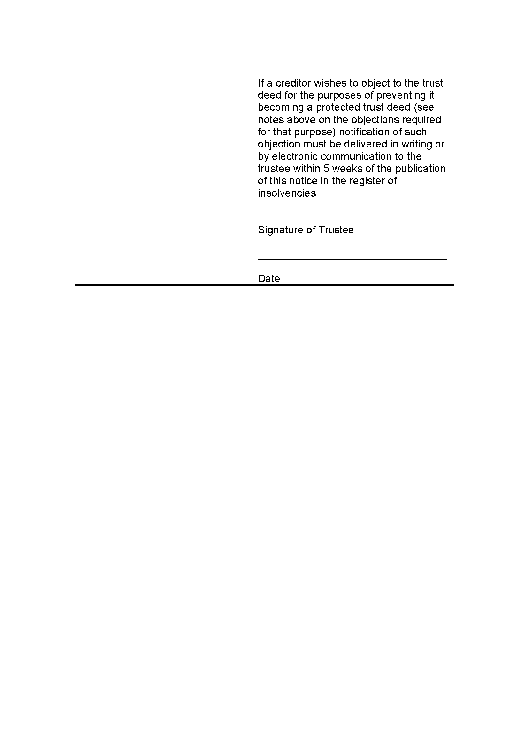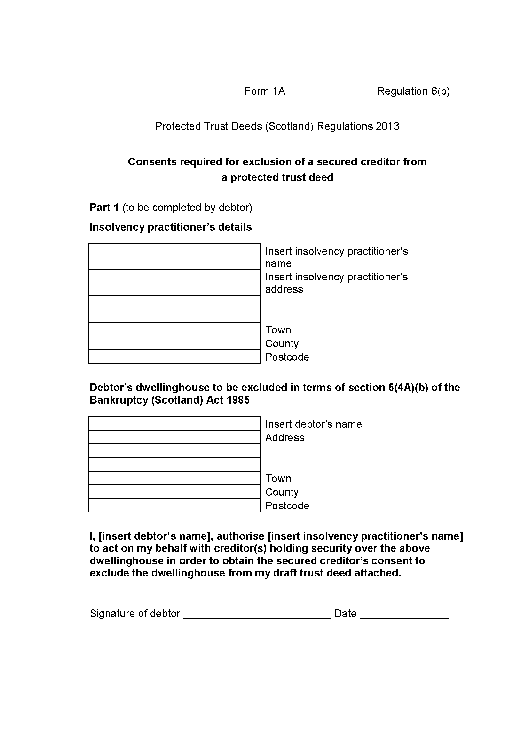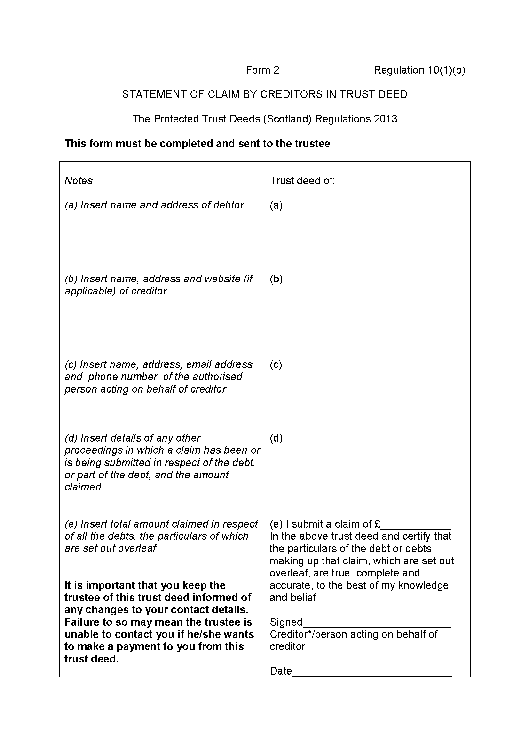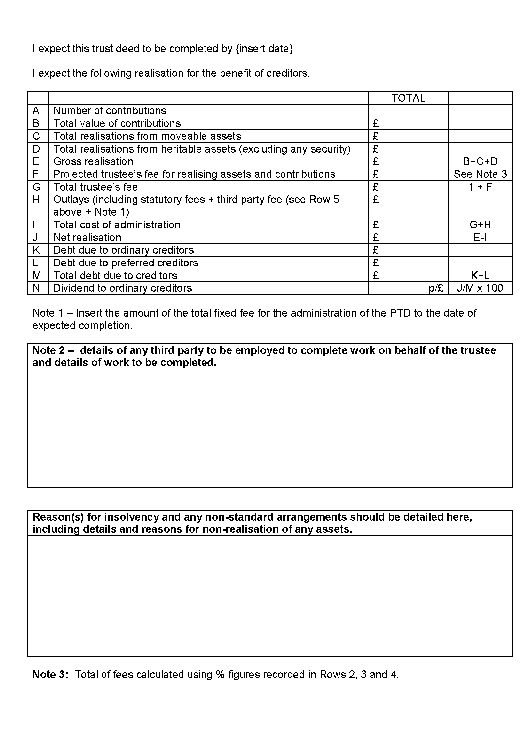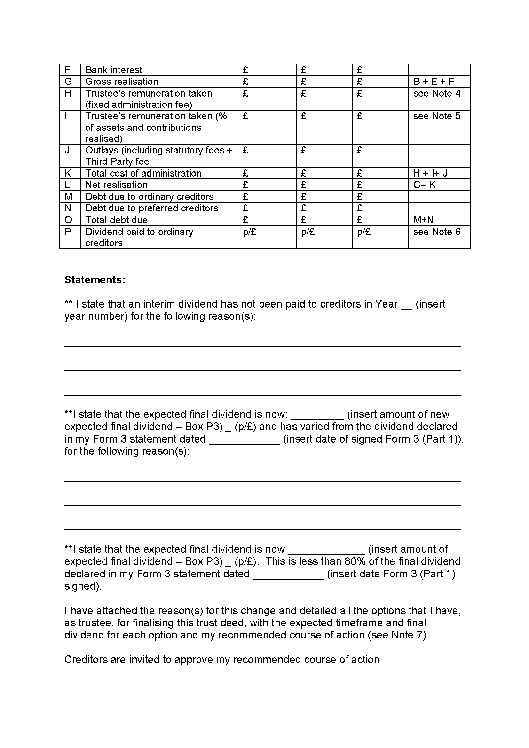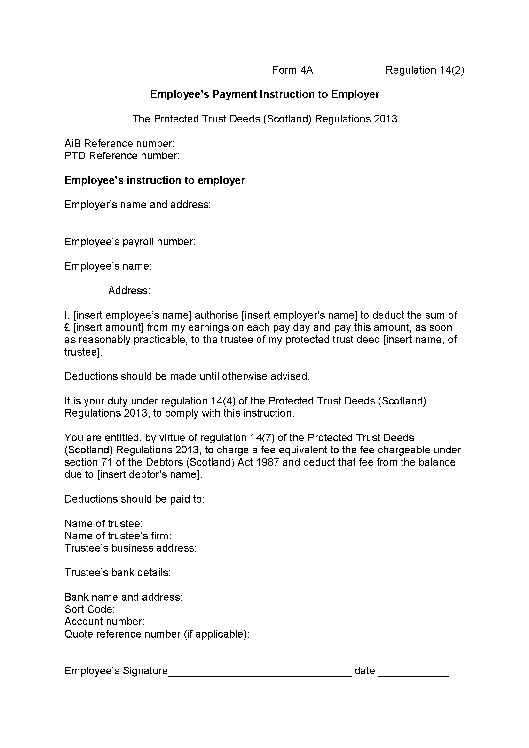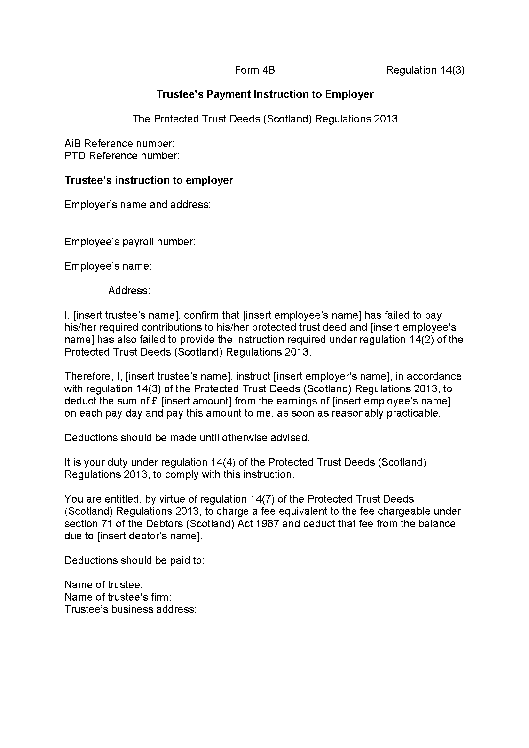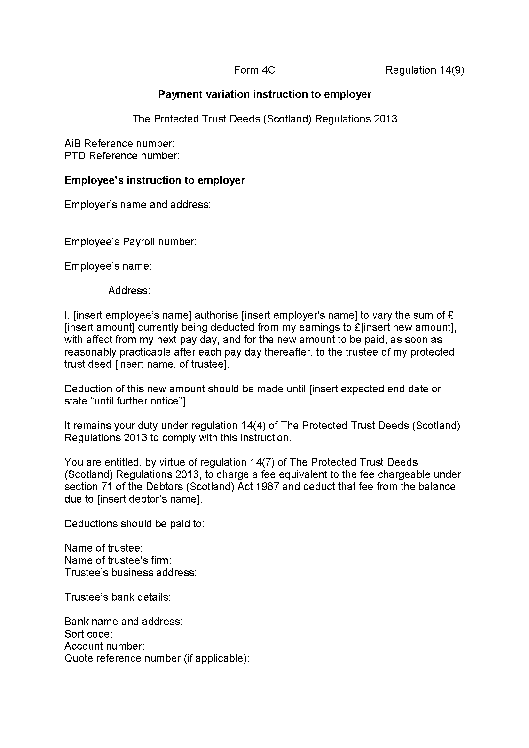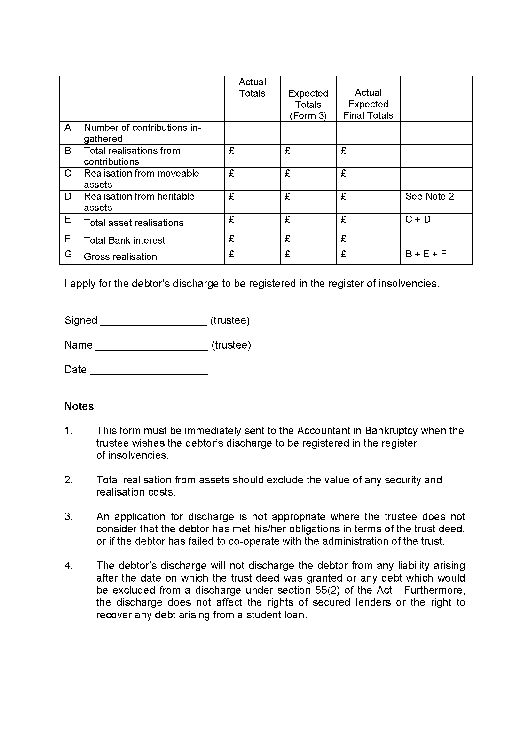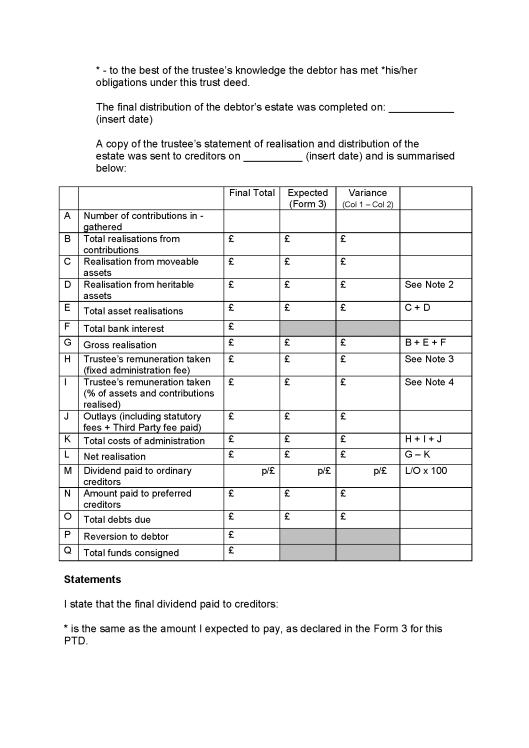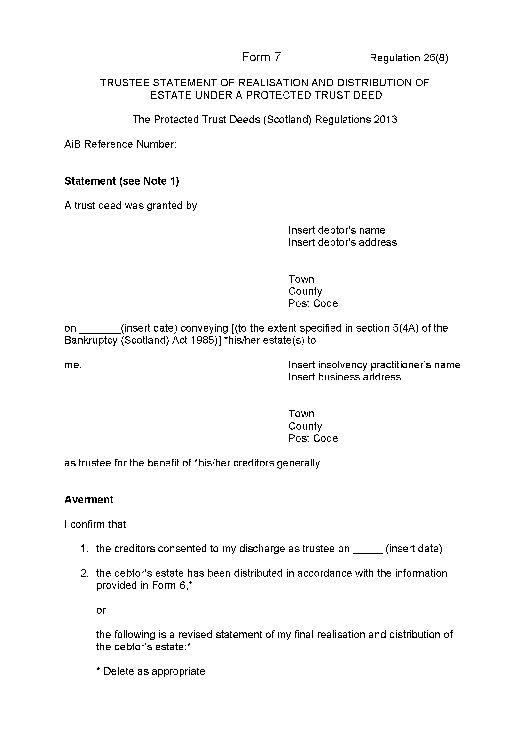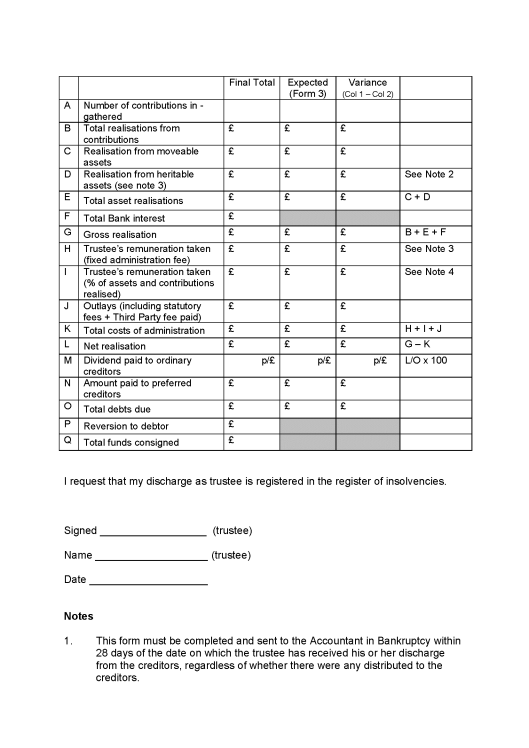Freely Available British and Irish Public Legal Information
[Home] [Databases] [World Law] [Multidatabase Search] [Help] [Feedback]
Statutory Instruments of the Scottish Parliament
You are here: BAILII >> Databases >> Statutory Instruments of the Scottish Parliament >> The Protected Trust Deeds (Scotland) Regulations 2013 No. 318
URL: http://www.bailii.org/scot/legis/num_reg/2013/ssi_2013318_en_1.html
[New search] [Printable PDF version] [Help]
Scottish Statutory Instruments
2013 No. 318
Bankruptcy
The Protected Trust Deeds (Scotland) Regulations 2013
Made
6th November 2013
Coming into force
28th November 2013
The Scottish Ministers make the following Regulations in exercise of the powers conferred by sections 69A and 72(1) of, and paragraph 5 of Schedule 5 to, the Bankruptcy (Scotland) Act 1985(1) and all other powers enabling them to do so.
In accordance with section 72(2) of that Act(2), a draft of this instrument has been laid before and approved by resolution of the Scottish Parliament.
PART 1GENERAL
Citation and commencement
1. These Regulations may be cited as the Protected Trust Deeds (Scotland) Regulations 2013 and come into force on 28th November 2013.
Interpretation
2. (1) In these Regulations-
"the Accountant" means the Accountant in Bankruptcy;
"the Act" means the Bankruptcy (Scotland) Act 1985;
"the 2008 Regulations" means the Protected Trust Deeds (Scotland) Regulations 2008(3);
"Common Financial Statement" means the style and format for income and expenditure categories under that title (and, where relevant, related spread sheets, budget sheets, trigger figures, guidance materials and notes) published by the Money Advice Trust(4);
"the EU Regulation" means Council Regulation (EC) No 1346/2000 of 29th May 2000 on insolvency proceedings(5);
"notified creditors" means all creditors to whom a trustee has sent documents in terms of regulation 10 (except for a secured creditor who has agreed not to claim in terms of regulation 6(c) in respect of excluding a dwellinghouse or part of a dwellinghouse);
"relevant period" means the period of 5 weeks beginning with the date of registration of the notice referred to in regulation 9;
"remuneration" means reasonable fees and outlays; and
"trust deed" means a trust deed that is intended to become a protected trust deed.
(2) A Form referred to by number in these Regulations means the Form so numbered in the Schedule.
Protected status
3. (1) A trust deed has the status of a protected trust deed if-
(a)the conditions set out in regulations 4 to 10 are met; and
(b)it is registered under regulation 11(2) in the register of insolvencies.
(2) A trust deed has that status from the date on which it is so registered.
PART 2CONDITIONS OF PROTECTION
The debtor
4. (1) The debtor who grants the trust deed must do so for a single estate and must be-
(a)a living individual;
(b)a partnership;
(c)a limited partnership (within the meaning of the Limited Partnerships Act 1907(6));
(d)a trust;
(e)a corporate body; or
(f)an unincorporated body of persons.
(2) The debtor must not be-
(a)a debtor whose estate has been sequestrated and the trustee in the sequestration has not been discharged under section 57 or 58A(7) of the Act; or
(b)an entity referred to in section 6(2) of the Act.
(3) The total amount of the debtor's debts (including interest) at the date on which the debtor grants the trust deed must be not less than £5,000.
The trustee
5. The trustee under the trust deed must be a person who would not be disqualified under section 24(2) of the Act from acting as the replacement trustee were the debtor's estate being sequestrated.
Exclusion of a secured creditor
6. Where a secured creditor is excluded from a trust deed under section 5(4A)(b)(ii)(8) of the Act, prior to the debtor granting the trust deed-
(a)the trustee must provide the debtor and the secured creditor with a valuation, made by a chartered surveyor or other suitably qualified third party, of the dwellinghouse (or part) which is to be excluded from the estate conveyed to the trustee under section 5(4A)(b)(i) of the Act;
(b)the debtor must, in Part 1 of Form 1A, request obtaining the secured creditor's agreement not to claim under the trust deed for any of the debt in respect of which the security is held; and
(c)the secured creditor's agreement must be set out in Part 2 of Form 1A.
Statements in relation to trust deed
7. (1) The trust deed must state-
(a)that, subject to any exclusion mentioned in section 5(4A)(b)(i) of the Act, all of the debtor's estate (other than property listed in section 33(1) of the Act or which would be excluded under any other provision of the Act or of any other enactment from vesting in the trustee of a sequestrated estate) is conveyed to the trustee;
(b)that the debtor agrees to convey to the trustee, for the benefit of creditors generally, any estate (wherever situated) which-
(i)is acquired by the debtor during a period of 4 years beginning with the date on which the trust deed is granted; and
(ii)would have been conveyed to the trustee under paragraph (1)(a) if it had been part of the debtor's estate on the date on which the trust deed was granted; and
(c)that any contribution from income for the benefit of creditors is payable in accordance with regulation 8.
(2) Where the debtor's dwellinghouse, or part of the debtor's dwellinghouse, is excluded as mentioned in section 5(4A)(b)(i) of the Act from the estate conveyed to the trustee, the trust deed must also include details-
(a)of any secured creditor who has agreed not to claim under the trust deed for any of the debt in respect of which the security is held; and
(b)of that debt.
(3) Before the debtor grants the trust deed-
(a)the trustee must advise the debtor that granting the deed may result-
(i)in the debtor's estate being sequestrated;
(ii)in the debtor being refused credit, whether before or after the debtor's discharge under regulation 24;
(iii)subject to any exclusion mentioned in section 5(4A)(b)(i) of the Act, in the debtor not being able to remain in the debtor's current place of residence;
(iv)subject to any such exclusion, in the debtor being required to relinquish property which the debtor owns;
(v)in the debtor being required to make contributions from income for the benefit of creditors;
(vi)in damage to the debtor's business interests and employment prospects; and
(vii)in the fact of the debtor having granted a trust deed becoming public information;
(b)the trustee must provide the debtor with a copy of a debt advice and information package referred to in section 10(5) of the Debt Arrangement and Attachment (Scotland) Act 2002(9); and
(c)the trustee and the debtor must sign a statement to the effect that the trustee has fulfilled the duties referred to in this paragraph.
Payment of debtor's contribution
8. (1) Where this regulation applies, the trust deed must state that the debtor must, during the payment period, pay the debtor's contribution from income at regular intervals.
(2) The payment period is-
(a)a minimum period of 48 months beginning with the date on which the trust deed was granted;
(b)such shorter period as is determined by the trustee; or
(c)such longer period as is-
(i)determined by the trustee where there is a period during which the debtor did not pay the debtor's contribution; or
(ii)agreed by the debtor and the trustee.
(3) The trustee may determine a shorter payment period only if, in the opinion of the trustee, payment of the debtor's contributions (from income or otherwise) during the shorter period would allow distribution of the debtor's estate to meet in full the total amount of the debtor's debts (including interest) at the date on which the debtor grants the trust deed.
(4) Where the debtor is a living individual, the debtor's contributions from income must be such as to result over the payment period in the payment of a sum less than the total amount of the debtor's debts (including interest) at the date on which the debtor grants the trust deed.
(5) In calculating the debtor's contributions from income for the purposes of paragraph (4), the whole of the debtor's surplus income over the amount allowed for expenditure in the statement of the debtor's income and expenditure supplied under regulation 10(1)(d)(ii) must be applied.
Notice in the register of insolvencies
9. After the trust deed has been delivered to the trustee, the trustee must without delay send a notice in Form 1 to the Accountant for publication by registration in the register of insolvencies.
Documents to be sent to creditors
10. (1) Not later than 7 days after registration under regulation 9, the trustee must send to every creditor known to the trustee (other than any secured creditor who has under section 5(4A)(b)(ii) of the Act agreed not to claim under the trust deed for any of the debt in respect of which the security is held)-
(a)a copy of the trust deed;
(b)a copy of Form 2 (to enable a creditor to make a statement of claim);
(c)a copy of the notice mentioned in regulation 9;
(d)a statement of the debtor's affairs, prepared by the trustee, containing-
(i)a list of the debtor's assets and liabilities;
(ii)a statement of the debtor's income and expenditure as at the date on which the trust deed was granted, in the style and format of the Common Financial Statement;
(iii)a statement as to the extent to which those assets and that income will not vest in the trustee;
(iv)a statement as to whether, and if so on what basis, the EU Regulation applies to the trust deed;
(v)if the EU Regulation does apply to the trust deed, a statement as to whether the proceedings are main proceedings or territorial proceedings;
(vi)a statement as to whether the creditors are likely to be paid a dividend and the amount of the dividend that is expected to be paid;
(vii)if the case is one in which there is an exclusion such as is mentioned in section 5(4A)(b)(i) of the Act, a statement by the trustee, on the basis of the information for the time being available to the trustee, as to what the effect of that exclusion is likely to be on any such dividend;
(viii)a statement that the trustee on request must provide a copy of any valuation held by the trustee which has been made by a third party and which relates to an asset of the debtor, any statement showing the amount due by the debtor under a security and any document showing the income for the time being of the debtor;
(ix)a copy of any agreement in Form 1B referred to in regulation 15(2);
(x)a statement explaining the conditions which require to be fulfilled before the trust deed will become a protected trust deed and the consequences of it becoming a protected trust deed;
(xi)details of any protected trust deed in respect of which, in the 6 months preceding publication of the notice provided for in regulation 9, the debtor has been discharged or refused a letter of discharge in terms of regulation 24(1) or (8) (or regulation 19(1) or (5) of the 2008 Regulations);
(xii)where a secured creditor's agreement has been obtained under regulation 6(c), a statement containing the valuation made by virtue of paragraph (a) of that regulation and a statement of the amount owed, in respect of the security held, to that creditor; and
(e)a statement in Part 1 of Form 3 of the trustee's anticipated realisations from the trust deed.
(2) The trust deed must be acceded to by the notified creditors but is deemed to have been acceded to by them unless, within the relevant period, the trustee receives notification in writing from a majority in number, or no fewer than one third in value, of the notified creditors that they object to the trust deed being granted protected status.
PART 3REGISTRATION AND EFFECT OF PROTECTION
Registration of the trust deed etc.
11. (1) As soon as reasonably practicable after the expiry of the relevant period (and in any event no later than 4 weeks after that expiry), the trustee must send to the Accountant for registration in the register of insolvencies-
(a)a copy of the trust deed;
(b)either-
(i)a copy of every form of agreement obtained by virtue of regulation 6(c); or
(ii)a statement by the trustee that no such form of agreement has been obtained;
(c)a statement by the trustee that those creditors, if any, who have objected in writing to the trust deed during the relevant period do not constitute a majority in number, or one third or more in value, of the creditors;
(d)a copy of the statement referred to in regulation 7(3)(c);
(e)a copy of the statement referred to in regulation 10(1)(d);
(f)a copy of any agreement in Form 1B referred to in regulation 15(2);
(g)a statement in the form of Form 3; and
(h)where the debtor makes a contribution from income, a statement-
(i)that the trustee assessed the debtor's expenditure against the trigger figures for expenditure published from time to time as part of the Common Financial Statement (leaving out of account the income and expenditure of any other person); and
(ii)explaining any instance in which those trigger figures are exceeded.
(2) The Accountant must register the trust deed in the register of insolvencies if-
(a)the Accountant has received all the documents required to be sent under paragraph (1);
(b)the conditions set out in regulations 4 to 10 have been met; and
(c)unless the Accountant is not satisfied that-
(i)any expenditure noted under paragraph (1)(h) or which it appears to the Accountant may be excessive; or
(ii)any contribution from income,
is appropriate having regard to any explanation provided by the trustee.
(3) The trustee must notify the debtor and every creditor known to the trustee of the registration of the trust deed in the register of insolvencies or the refusal by the Accountant to so register the trust deed by no later than 7 days after receipt of the notification of the same by the Accountant.
Effect of protected status
12. (1) Where a trust deed has become a protected trust deed then-
(a)subject to regulation 17, a creditor who (either or both)-
(i)is not a notified creditor; or
(ii)notified the trustee of objection to the trust deed during the relevant period,
has no higher right to recover the debt than a creditor who has acceded to, or been deemed by virtue of regulation 10(2) to have acceded to, the trust deed; and
(b)an application for sequestration of the debtor's estate may not be made by the debtor while the trust deed subsists.
(2) A creditor ceases to be deemed to have acceded to a trust deed in terms of regulation 10(2) if the trustee refuses a request by the debtor to apply to the Accountant for discharge in terms of regulation 24(8).
(3) Where a secured creditor's agreement has been obtained under regulation 6(c) and the trust deed becomes a protected trust deed, that creditor is not entitled-
(a)to make a claim under the protected trust deed for any of the debt in respect of which the security is held;
(b)to do diligence against the assets conveyed to the trustee under the protected trust deed; or
(c)to petition for the sequestration of the debtor during the subsistence of the protected trust deed.
Effect of protected status on diligence against earnings
13. (1) This regulation has effect where a trust deed has protected status.
(2) Any existing earnings arrestment, current maintenance arrestment or, subject to paragraph (3), conjoined arrestment order ceases to have effect on the date of protection.
(3) Any sum paid by the employer to the sheriff clerk under a conjoined arrestment order on a pay day occurring before the date of protection will be disbursed by the sheriff clerk under section 64 of the Debtors (Scotland) Act 1987(10) notwithstanding that the date of disbursement is after the date of protection.
(4) The execution of an earnings arrestment or the making of a conjoined arrestment order is not competent after the date of protection to enforce a debt in respect of which the creditor is entitled to make a claim under the trust deed.
(5) A deduction from earnings order under the Debtors (Scotland) Act 1987 is not competent after the date of protection to secure the payment of any amount due by the debtor under a maintenance calculation within the meaning of that Act in respect of which a claim could be made under the trust deed.
Deductions from debtor's earnings
14. (1) This regulation applies where-
(a)a debtor is required to pay to the trustee a contribution from income for the benefit of creditors and an amount is required to be paid from the debtor's earnings from employment; and
(b)the debtor has failed on two consecutive occasions to pay to the trustee the required amount of the debtor's income from the debtor's earnings from employment.
(2) Following a request by the trustee, the debtor must give the person by whom the debtor is employed an instruction in Form 4A to make-
(a)deductions of specified amounts from the debtor's earnings; and
(b)payments to the trustee of the amounts so deducted.
(3) The trustee may give the person by whom the debtor is employed an instruction of the type mentioned in paragraph (2) in Form 4B if the debtor fails to comply with the requirement imposed by that paragraph.
(4) The employer must comply with an instruction provided in accordance with paragraph (2) or (3) (or varied in accordance with paragraph (9)).
(5) On delivery of the instruction and while the instruction is in effect, the employer must deduct the sum specified in the instruction on every pay day, and pay the sum deducted to the trustee as soon as it is reasonably practicable to do so.
(6) Where an employer fails without good cause to make a payment due under an instruction, the employer is-
(a)liable to pay on demand by a trustee the amount that should have been paid; and
(b)not entitled to recover from a debtor the amount paid to the debtor in breach of the instruction.
(7) An employer may on making a payment due under an instruction charge a fee equivalent to the fee chargeable for the time being under section 71 (employer's fee for operating diligence against earnings) of the Debtors (Scotland) Act 1987(11) and deduct that fee from the balance due to the debtor.
(8) The trustee must, without delay after the discharge of a debtor under regulation 24, notify in writing any person who has received an instruction in accordance with paragraph (2) or (3) (or varied in accordance with paragraph (9)) that the instruction has been recalled.
(9) Following agreement by the debtor and the trustee, the debtor may give to the person by whom the debtor is employed a variation to the instruction mentioned in paragraph (2) in Form 4C.
Agreement in respect of debtor's heritable property
15. (1) This regulation does not apply to the debtor's dwellinghouse (or any part of that dwellinghouse) if the dwellinghouse or part is excluded from the estate conveyed to the trustee in accordance with section 5(4A)(b)(i) of the Act.
(2) Subject to the conditions in paragraph (3), the trustee may agree in Form 1B at the date on which the trust deed was granted-
(a)not to realise any specified heritable estate of the debtor which has been conveyed to the trustee;
(b)to relinquish the trustee's interest in respect of such heritable estate; and
(c)to recall any notice of inhibition in respect of such heritable estate in accordance with paragraph 2(2) of Schedule 5 to the Act.
(3) The conditions are-
(a)the debtor must-
(i)pay any amount determined by the trustee by the date determined by the trustee;
(ii)following the payment period under regulation 8(2) where there is a contribution from income, pay a monthly amount determined by the trustee for a period determined by the trustee; and
(b)the debtor must co-operate with the administration of the trust.
(4) The amount of the debtor's payments under paragraph (3)(a)(i) and (ii) must be determined in accordance with a valuation made by a chartered surveyor or other suitably qualified third party of the debtor's heritable estate as at the date of grant of the trust deed.
(5) If the debtor fails to fulfil a condition mentioned in paragraph (3), the trustee may withdraw from the agreement.
(6) The trustee must, as soon as is practicable, send a copy of the agreement mentioned in paragraph (2) in Form 1B to the Accountant and to every creditor known to the trustee (other than any secured creditor who has under section 5(4A)(b)(ii) of the Act agreed not to claim under the trust deed for any of the debt in respect of which the security is held).
Dividend payments
16. (1) If the funds of the debtor's estate are sufficient, the trustee must pay a dividend out of the estate to the creditors no later than 6 weeks after the end of-
(a)a first dividend period of 24 months beginning with the date on which the trust deed was granted; and
(b)any subsequent dividend period of 6 months beginning with the end of the previous dividend period.
(2) The funds of the debtor's estate are "sufficient" if-
(a)after deduction of the trustee's fees and any outlays payable under these Regulations; and
(b)after making allowance for future contingencies,
a dividend may be paid to the creditors amounting to at least 5 pence for each pound sterling of the debtor's debt under the trust deed on the date on which the trust deed was protected.
Sequestration petition by qualified creditor
17. (1) A qualified creditor who is not a notified creditor, or who has notified the trustee of objection to the trust deed within the relevant period, may present a petition to the sheriff for sequestration of the debtor's estate-
(a)not later than 5 weeks after the date of registration of the notice under regulation 9; or
(b)at any time if the creditor avers that the provision for distribution of the estate is, or is likely to be, unduly prejudicial to a creditor or class of creditors.
(2) Paragraph (1)(b) is subject to section 8(1)(b) of the Act.
(3) The sheriff may award sequestration in pursuance of-
(a)paragraph (1)(a), only if satisfied that to do so would be in the best interests of the creditors; and
(b)paragraph (1)(b), only if satisfied that the creditor's averment is correct.
Creditor's application as respects intromissions of trustee
18. (1) A creditor who is not sent a copy of the notice mentioned in regulation 10(1)(c) or who has notified the trustee of objection to the trust within the relevant period may apply to the sheriff under this regulation.
(2) Where on such an application the sheriff is satisfied, on grounds other than those on which a petition under regulation 17(1)(b) has been or could have been presented by the creditor, that the intromissions of the trustee with the estate of the debtor have been so unduly prejudicial to the creditor's claim that the creditor should not be bound by the trustee's discharge, the sheriff may order that the creditor will not be so bound.
(3) On the sheriff making an order under paragraph (2), the sheriff clerk must-
(a)send a copy of the order to the trustee; and
(b)send a copy of the order to the Accountant for registration in the register of insolvencies.
(4) An application under paragraph (1) must be made no later than 28 days after the registration in the register of insolvencies of the trustee's statement of realisation and distribution of estate under the protected trust deed, as mentioned in regulation 25(7)(b).
(5) For the purposes of paragraph (2), the sheriff to whom the application may be made is the sheriff to whom a petition for sequestration would be brought in respect of the debtor by virtue of section 9(1) or (2) of the Act.
PART 4ADMINISTRATION, ACCOUNTING AND DISCHARGE
Directions to trustee under protected trust deed
19. (1) The Accountant may give directions to the trustee under a protected trust deed as to how the trustee should conduct the administration of the trust.
(2) On a direction being issued to the trustee by virtue of paragraph (1) its terms are to be intimated to the debtor and to all known creditors.
(3) The direction may be issued on the initiative of the Accountant or (at the Accountant's discretion) on the request of the trustee, the debtor or any creditor.
(4) The trustee must, unless paragraph (5) applies, comply with the direction within the period of 30 days beginning with the day on which the direction is given.
(5) Where the trustee has made an appeal to the sheriff under regulation 27(1)(b) and the appeal has been dismissed by the sheriff or withdrawn by the trustee, the trustee must comply with the direction within the period of 30 days beginning with the day on which (as the case may be)-
(a)the appeal was dismissed by the sheriff; or
(b)the appeal was withdrawn by the trustee.
(6) If it appears to the Accountant that the trustee has failed, without reasonable excuse, to comply with the direction, the Accountant may report the matter to the sheriff who, after hearing the trustee on the matter, may-
(a)censure the trustee; or
(b)make such other order as the circumstances of the case require.
Information and notification obligations of trustee under protected trust deed
20. (1) Where the trustee under a protected trust deed makes a determination to shorten or lengthen the payment period under regulation 8, the trustee must notify the debtor of the determination without delay.
(2) Whether or not still acting in the administration of the trust under a protected trust deed, the trustee must supply the Accountant with such information relating to the trust deed as the Accountant considers necessary to enable the Accountant to discharge the Accountant's functions under the Act or these Regulations.
(3) If it appears to the Accountant that the trustee has failed, without reasonable excuse, to supply information to the Accountant which is requested in accordance with paragraph (2), the Accountant may report the matter to the sheriff who, after hearing the trustee on the matter may-
(a)censure the trustee; or
(b)make such other order as the circumstances of the case require.
(4) On the trustee under a protected trust deed being replaced with a new trustee, the new trustee must notify the Accountant accordingly without delay.
Administration of trust under protected trust deed
21. (1) At intervals of not more than 12 months (the first such interval beginning with the date on which the trust deed was granted) and by no later than 6 weeks after the end of each interval, the trustee under a protected trust deed must send the trustee's accounts of the trustee's intromissions with the debtor's estate in administering the trust during the period in question-
(a)to the debtor;
(b)to each creditor; and
(c)to the Accountant (unless they are sent under regulation 25).
(2) At such intervals the trustee must send to the Accountant, the debtor and each creditor a report in Form 4 on the management of the trust during the period in question.
(3) The debtor or any creditor may, within 14 days after receiving a statement by virtue of paragraph (1), require the Accountant to exercise the function mentioned in section 1A(1)(a)(iia) of the Act by carrying out an examination of the administration of the trust by the trustee.
(4) In determining the amount of any contribution from income to be made by the debtor, the trustee may take account of any social security benefit paid to the debtor but any contribution must not include an amount derived from social security benefit.
Retention of documents by trustee under protected trust deed
22. The trustee under a protected trust deed must retain the following documents (or copies of those documents) for a period of at least 12 months after the date of the trustee's discharge under regulation 25-
(a)the trust deed;
(b)the statement mentioned in regulation 7(3)(c);
(c)the notice mentioned in regulation 9;
(d)the statement mentioned in regulation 10(1)(d);
(e)all statements of objection or accession received from creditors;
(f)the statement of anticipated realisations mentioned in regulation 10(1)(e);
(g)any written agreement relating to the debtor's heritable estate mentioned in regulation 15(2);
(h)all reports sent under regulation 21(2);
(i)any adjudication on a creditor's claim;
(j)any scheme of division among creditors;
(k)any circular sent to creditors with accounts;
(l)the debtor's discharge from the trust deed in Form 5;
(m)the application to creditors for the trustee's discharge;
(n)the statement of realisation and distribution mentioned in regulation 25(7)(b);
(o)any decree, interlocutory decree, direction or order relating to the administration of the trust which is granted by the court;
(p)any other document relating to the administration of the trust if it is a document which the Accountant, by notice to the trustee prior to the trustee's discharge, identifies as a document the trustee should retain.
Remuneration payable to trustee under protected trust deed
23. (1) For work done by the trustee in administering the trust, the trustee under a protected trust deed is entitled to remuneration which may consist of-
(a)a fixed fee which must be set out in the Form 3 ("fixed fee");
(b)an additional fee based upon a percentage of the total assets and contributions realised by the trustee which must be set out in the Form 3; and
(c)outlays incurred after the date on which the trust deed was granted.
(2) In the event of unforeseen circumstances, the fixed fee may be increased by-
(a)approval by a majority in value of the notified creditors; or
(b)all notified creditors having first been asked to approve the increase, approval by the Accountant.
(3) The Accountant is to approve an increase in the fixed fee if satisfied-
(a)that a majority in number of the notified creditors have not refused to approve the increase in the fixed fee; and
(b)that the increase in the fixed fee is required for work to be completed by the trustee for the benefit of the creditors generally that was not foreseen in submitting the Form 3.
(4) In deciding whether or not to grant the approval mentioned in paragraph (2)(b), the Accountant may determine the amount of any increase in the fixed fee.
(5) The trustee is entitled to include work done in seeking to comply with regulation 6 (whether or not a secured creditor has agreed not to claim under the trust deed) in the fixed fee and any outlays incurred.
(6) Any debt due to a third party for work done before the granting of the trust deed does not rank higher than any other creditor's claim.
(7) The trustee is entitled to recover from the debtor's estate any audit fee charged by the Accountant under paragraph 1 or 1A of Schedule 5 to the Act in accordance with the rate specified in the Table of Fees in Schedule 1 to the Bankruptcy Fees etc. (Scotland) Regulations 2012(12).
(8) The Accountant may, at any time, audit the trustee's accounts and fix the outlays of the trustee in the administration of the trust.
Discharge of debtor
24. (1) If the conditions set out in paragraph (2) are met, subject to paragraphs (6), (9) and (11)-
(a)the debtor will be discharged from all debts and obligations-
(i)in terms of the trust deed; or
(ii)for which the debtor was liable as at the date that deed was granted; and
(b)the trustee under the protected trust deed must send-
(i)to the Accountant, an application for discharge of the debtor in Form 5; and
(ii)to the debtor, a copy of that application.
(2) The conditions are-
(a)that the trustee makes a statement in the Form 5 that, to the best of the trustee's knowledge the debtor has-
(i)met the debtor's obligations in terms of the trust deed; and
(ii)co-operated with the administration of the trust; and
(b)any notice of inhibition under paragraph 2 of Schedule 5 to the Act has been recalled or has expired.
(3) If the conditions set out in paragraph (2) are met and unless paragraph (11) applies, on receipt of the Form 5 referred to in paragraph (1)(b)(i), the Accountant must register it in the register of insolvencies and the date of discharge is the date on which it is so registered.
(4) The Accountant must notify the trustee of the fact of registration and the date of the debtor's discharge without delay.
(5) The trustee must notify the debtor and every creditor known to the trustee of the information set out in the notification mentioned in paragraph (4) by no later 7 days after the date of receipt of the notification.
(6) The letter of discharge does not-
(a)discharge the debtor from any liability arising after the date on which the trust deed was granted;
(b)discharge the debtor from any liability or obligation mentioned in section 55(2) of the Act;
(c)discharge the debtor from any liability for a debt in respect of which a security is held if the secured creditor has agreed under section 5(4A)(b)(ii) of the Act not to claim under the trust deed for any of the debt in respect of which the security is held; or
(d)affect the rights of a secured creditor.
(7) For the purposes of paragraph (2)(a)(i), it is not a failure to meet the debtor's obligations-
(a)for the debtor to refuse to consent to the sale of the debtor's dwellinghouse (or of a part of that dwellinghouse) if the dwellinghouse or part is excluded from the estate conveyed to the trustee in accordance with section 5(4A)(b) of the Act;
(b)for the debtor to refuse to give a relevant consent in terms of section 40(1)(a) of the Act.
(8) If on request by the debtor, or at the end of the period of 48 months beginning with the day on which the trust deed was granted, the trustee refuses to apply to the Accountant for discharge of the debtor, the trustee must-
(a)inform the debtor in writing-
(i)of the fact and the reason for the refusal;
(ii)that the debtor is not discharged from the debtor's debts and obligations in terms of the trust deed; and
(iii)of the debtor's right to apply to the sheriff for a direction as regards the administration of the trust in accordance with regulation 28(1); and
(b)send a copy of this written notification to the Accountant by no later than 21 days after the date of issue of the notification.
(9) This regulation does not affect the right to recover any debt arising from a student loan.
(10) In paragraph (9), "student loan" means a loan made-
(a)by virtue of regulations made under section 73(f) of the Education (Scotland) Act 1980(13);
(b)under section 1 of the Education (Student Loans) Act 1990(14);
(c)by virtue of regulations made under section 22 of the Teaching and Higher Education Act 1998(15); or
(d)by virtue of regulations made under Article 3 of the Education (Student Support) (Northern Ireland) Order 1998(16).
(11) The Accountant may refuse to register a Form 5 in the register of insolvencies if the Accountant is not satisfied that the debtor has-
(a)met the debtor's obligations in terms of the trust deed; or
(b)co-operated with the administration of the trust.
(12) If paragraph (11) applies and the Accountant refuses to register the Form 5 in the register of insolvencies, the Accountant must provide written notification of that refusal and the reason for it to the trustee and the debtor.
(13) The trustee must send a copy of the notification mentioned in paragraph (12) to every creditor known to the trustee by no later than 7 days after the date of receipt of the notification.
Discharge of trustee
25. (1) This regulation applies where a trustee under a protected trust deed has made the final distribution of the trust estate among the creditors.
(2) Not more than 28 days after the date of final distribution, the trustee must apply in Form 6 for discharge to such of those creditors as have acceded (or are deemed to have acceded) to the trust deed.
(3) The trustee must send to the Accountant by the date of application-
(a)a copy of the Form 6; and
(b)the accounts of the trustee's intromissions for the last period for which accounts must be sent under regulation 21(1).
(4) For the purposes of paragraph (2), the "date of final distribution" is the date on which all of the estate distributed has been placed beyond the control of the trustee.
(5) A creditor who does not respond to the trustee's application within 14 days after the trustee makes it is deemed to have agreed to the trustee's discharge.
(6) If a majority of the creditors in value consent to the application, the trustee is discharged.
(7) On being discharged, the trustee must within 28 days of the date of discharge-
(a)inform the Accountant of the discharge;
(b)send the Accountant, for registration in the register of insolvencies, a statement of realisation and distribution of estate under the protected trust deed; and
(c)send the Accountant, where accounts submitted under paragraph (3)(b) require to be revised, the revised accounts.
(8) A statement under paragraph (7)(b) is to be in Form 7.
(9) Where the trustee's discharge is granted under this regulation, the discharge also applies as regards any previous trustee under the trust deed unless, under regulation 28, a person with an interest obtains an order to the contrary from the sheriff.
Electronic delivery of notices etc.
26. (1) Any notice or document authorised or required under these Regulations may be given, delivered or sent by electronic means, provided the intended recipient has-
(a)consented (whether in the specific case or generally) to electronic delivery (and has not withdrawn that consent); and
(b)provided an electronic address for delivery.
(2) In the absence of evidence to the contrary, a notice or other document is be presumed to have been delivered under these Regulations where-
(a)the sender can produce a copy of the electronic message which-
(i)contained the notice or other document, or to which the notice or other document was attached; and
(ii)shows the time and date the message was sent; and
(b)that electronic message was sent to the address supplied under paragraph (1)(b).
(3) This regulation does not apply where some other form of delivery is required by court rules or by order of the court.
PART 5APPEALS AND DIRECTIONS
Appeal
27. (1) The persons mentioned in paragraph (2) may appeal to the sheriff by way of summary application against-
(a)any refusal by the Accountant to register a trust deed on the ground that the Accountant is not satisfied expenditure allowed or a contribution from income is appropriate under regulation 11(2)(c);
(b)any determination by the Accountant fixing the remuneration payable to the trustee under a protected trust deed;
(c)any direction under regulation 19(1) to the trustee; or
(d)a refusal by the Accountant under regulation 24(11) to register Form 5 in the register of insolvencies.
(2) The persons are-
(a)the trustee;
(b)the debtor if able to satisfy the sheriff that the debtor has, or is likely to have, a pecuniary interest in the outcome of the appeal; and
(c)any creditor if able to satisfy the sheriff that the creditor has, or is likely to have, any such interest in that outcome.
(3) The trustee may appeal to the sheriff by way of summary application against a refusal by the creditors to grant the trustee's discharge under regulation 25(2).
(4) The debtor may appeal to the sheriff by way of summary application against a refusal by the trustee to apply under regulation 24(1)(b)(i) for approval of the debtor's discharge.
(5) Any appeal under paragraph (1) must be made no later than 21 days after (as the case may be)-
(a)the determination is made; or
(b)the direction is given.
(6) The sheriff to whom any appeal under this regulation is to be made is the sheriff who, had a petition for the sequestration of the estate been presented at the date the trust deed was granted, would have had jurisdiction to hear that petition in terms of section 9(1) or (2) of the Act.
(7) The decision of the sheriff on an appeal under this regulation is final.
Sheriff's direction
28. (1) Any person with an interest may at any time apply to the sheriff for a direction as regards the administration of the trust deed.
(2) A direction by virtue of paragraph (1) may include-
(a)any order the sheriff thinks fit to make in the interests of justice; or
(b)an order to cure any defect in procedure.
(3) The sheriff to whom any application under this regulation is to be made is the sheriff who, had a petition for the sequestration of the estate been presented at the date the trust deed was granted, would have had jurisdiction to hear that petition in terms of section 9(1) or (2) of the Act.
PART 6FEES AMENDMENTS, REVOCATIONS, SAVINGS AND TRANSITIONALS
Amendment of the Bankruptcy Fees etc. (Scotland) Regulations 2012
29. (1) The Bankruptcy Fees etc. (Scotland) Regulations 2012(17) are amended as follows.
(2) In regulation 12(a) (repayment of fees - failure of protected trust deed), for "regulation 19(1)(a) of the Protected Trust Deeds (Scotland) Regulations 2008" substitute "regulation 24(2)(a) of the Protected Trust Deeds (Scotland) Regulations 2013".
(3) In item 17 of Part 2 of the Table of Fees in Schedule 1 (fees in respect of protected trust deeds), immediately before item (a) insert-
| "(za) | for publishing a notice in the register of insolvencies(18) where- | |||
| (i) | the notice is sent by the trustee using the electronic service provided by the Accountant in Bankruptcy; | £35.00 | None | |
| (ii) | the notice is sent by the trustee by any other method. | £90.00 | None" | |
Revocation
30. These instruments are revoked-
(a)the 2008 Regulations(19); and
(b)the Protected Trust Deeds (Scotland) Amendment Regulations 2010(20).
Saving and transitional
31. (1) Notwithstanding revocation of the 2008 Regulations by regulation 30, the revoked Regulations continue to apply to any trust deed granted before 28th November 2013.
(2) Form 5 in Schedule 1 to the 2008 Regulations (letter of discharge of debtor) continues so to apply as if for "discharged from *his/her protected trust deed on _________ (insert date)" were substituted "discharged from the protected trust deed on the date the debtor's discharge is recorded in the Register of Insolvencies".
FERGUS EWING
Authorised to sign by the Scottish Ministers
St Andrew's House,
Edinburgh
6th November 2013
Regulation 2(2)
SCHEDULELIST OF FORMS TO BE USED IN CONNECTION WITH PROTECTED TRUST DEEDS
Form | Purpose | Relevant provision of the Regulations |
|---|---|---|
| 1 | Notice in the register of insolvencies by trustee under a trust deed for the benefit of creditors | Regulation 9 |
| 1A | Consents required for exclusion of a secured creditor from a protected trust deed | Regulation 6(b) |
| 1B | Agreement in respect of heritable property | Regulation 15(2) |
| 2 | Statement of claim by creditors in trust deed | Regulation 10(1)(b) |
| 3 | Trust deed protection proposal and trustee's application | Regulation 10(1)(e) and 11(1)(g) |
| 4 | Trustee's statement of status of a protected trust deed | Regulation 21(2) |
| 4A | Employee's payment instruction to employer | Regulation 14(2) |
| 4B | Trustee's payment instruction to employer | Regulation 14(3) |
| 4C | Payment variation instruction to employer | Regulation 14(9) |
| 5 | Application for discharge of debtor | Regulation 24(1)(b) |
| 6 | Application to creditors for discharge of the trustee of a protected trust deed | Regulation 25(2) |
| 7 | Trustee statement of realisation and distribution of estate under a protected trust deed | Regulation 25(8) |
EXPLANATORY NOTE
(This note is not part of the Regulations)
These Regulations make provision about how voluntary trust deeds entered into by debtors for the benefit of their creditors become protected from action by creditors, the consequences of a trust deed being granted that status, the rights of creditors, the discharge of the debtor and trustee from the trust deed, and the administration of trust deeds.
Trust deeds can be protected under paragraph 5 of Schedule 5 to the Bankruptcy (Scotland) Act 1985 as amended by the Bankruptcy and Diligence etc (Scotland) Act 2007 and section 10 of the Home Owner and Debtor Protection (Scotland) Act 2010.
Regulation 3 provides that a trust deed has protected status from the date when it is registered in the Register of Insolvencies by the Accountant in Bankruptcy, who must record the deed following receipt of certain documents from the trustee (regulation 11). Before registration certain conditions require to be met, set down in regulations 4 to 10-
Regulation 4 states who can and cannot be a debtor under a trust deed and regulation 5 states who can be a trustee under such deeds.
Regulation 6 prescribes additional conditions for a trust deed which excludes a dwellinghouse: the trustee must provide the debtor and secured creditor with a valuation, the debtor consent to the trustee dealing with the secured creditor and the secured creditor consent, using consent Form 1A.
After the trust deed is signed by the debtor a statement must be signed by the trustee and the debtor (regulation 7(3)(c)) confirming that the trustee provided the debtor with advice about the effect of the trust deed and that the debtor agreed in the trust deed to estate acquired after the grant of the trust deed (i.e. acquirenda) going to the trustee (regulation 7(1)(b)). The trust deed must contain further details if a debtor's dwellinghouse is excluded (regulation 7(2)).
Where a contribution from the debtor's income is taken, under regulation 8 it must be payable under the trust deed for the "payment period" of 48 months unless that period is varied.
The creditors must be notified through publication by registration in the Register of Insolvencies (regulation 9).
Not later than 7 days after the notice is published, the trustee must send certain documents to the creditors who have 5 weeks to object, and unless the majority in number (or not less than one third in value) do not so object, they are deemed to accede to the trust deed (regulation 10). The definition of "notified creditors" in regulation 2 makes clear with regulation 10(2) that a secured creditor of an excluded dwellinghouse cannot vote for these purposes. Where a dwellinghouse is excluded, other creditors receive additional information on the effect of an exclusion on any dividend, on any trust deeds in the previous 6 months, on the value of the excluded dwellinghouse and on the debt owed to the secured creditor.
Regulation 11 provides that the trustee must send information on all trust deeds, including on any dwellinghouse excluded, to the Accountant in Bankruptcy, within 4 week time limit. It also provides for when the Accountant in Bankruptcy must register the trust deed as protected.
Regulations 12 to 18 provide for the consequences of a trust deed becoming protected, including the consequences of a trust deed becoming protected for a secured creditor who has consented to the exclusion (regulation 12(3)), the circumstances in which a qualified creditor can petition for sequestration (regulation 17) and which creditors can apply to the courts (regulation 18).
Regulations 19 to 23 deal with the administration of the trust deed. Regulation 19 gives the Accountant in Bankruptcy power to give directions to the trustee as to how the administration should be conducted, with intimation of the terms of the direction to the debtor and creditors. Regulation 20 requires the trustee to provide information to the trustee and the Accountant in Bankruptcy as required and the trustee can be reported to the sheriff for failures, and subject to censure or other orders. Under regulation 21, the trustee is required to send statements of account to the debtor, creditors and the Accountant in Bankruptcy. The trustee is also required to send a report on the management of the trust deed to the Accountant in Bankruptcy. The trustee cannot take any contribution from income from social security benefit (regulation 21(4)). Regulation 22 stipulates documents the trustee must retain for 12 months after the trustee's discharge.
Regulation 23 deals with the trustee's remuneration. The remuneration must consist of a fixed fee and an additional fee based on a percentage of assets realised together with outlays, subject to unforeseen circumstances. The fee can include remuneration for work done in seeking a secured creditor's consent prior to a trust deed becoming protected. The Accountant in Bankruptcy may, at any time, audit the trustee's accounts and fix the outlays of the trustee in the administration of the trust.
Regulation 24 sets out the conditions which must be met for a debtor to be discharged of debts and obligations under the protected trust deed. If they have been met, the trustee must send a letter of discharge to the debtor. Refusal to sell a dwellinghouse as defined in section 5(4AA) of the 1985 Act or a family home as defined in section 40(4) of the 1985 Act is not treated as failure to meet a debtor's obligations. Once the Accountant in Bankruptcy receives a copy of the letter, the debtor's discharge must be recorded in the Register of Insolvencies and the discharge is effective from that date. If the trustee decides a debtor is not discharged, the debtor may appeal to the sheriff. Student loans cannot be discharged under a protected trust deed.
Regulation 25 deals with the discharge of the trustee and defines the date of the final distribution (only for the purposes of regulation 25) including what actions must be carried out by the trustee once discharged. A trustee can still seek discharge where a creditor has not yet collected the funds of the distribution, provided the funds have been placed beyond the control of the trustee.
Regulation 26 provides for electronic delivery of notices and other documents and a presumption for when electronic delivery is taken to have occurred.
Regulation 27 allows inter alia appeals to be made by the debtor, creditor or trustee to the sheriff by way of summary application against any refusal by the Accountant to register a trust deed on the ground that the Accountant is not satisfied that expenditure allowed or a contribution from income is appropriate under regulation 11(2)(c). Appeal is also allowed against any determination by the Accountant in Bankruptcy fixing the remuneration payable to the trustee, or any direction by the Accountant to the trustee as to the conduct of the administration of the trust deed.
Regulation 28 provides for a general direction-making power of the sheriff on the application of any interested party.
Regulation 29 amends fees payable under the Bankruptcy Fees etc. (Scotland) Regulations 2012 in respect of protected trust deeds.
Regulation 30 revokes the Protected Trust Deeds (Scotland) Regulations 2008 and an amending instrument, which these Regulations replace, subject to the saving in regulation 31(1) under which those Regulations will continue to apply to trust deeds granted before 28th November 2013 and a transitional modification in regulation 30(2) which corrects an error in those Regulations as they will continue to apply to those trust deeds.
A Business and Regulatory Impact Assessment has been prepared for these Regulations. Copies can be obtained from the Accountant in Bankruptcy's website: http://www.aib.gov.uk.
1985 c.66 ("the 1985 Act"). Section 69A of the 1985 Act was inserted by section 8 of the Bankruptcy (Scotland) Act 1993 (c.6). Section 72(1) of the 1985 Act was amended (and renumbered) by section 35 of the Bankruptcy and Diligence etc. (Scotland) Act 2007 (asp 3) ("the 2007 Act"). Paragraph 5 of Schedule 5 to the 1985 Act was amended by section 20 of the 2007 Act and by section 13(2) of the Home Owner and Debtor Protection (Scotland) Act 2010 (asp 6). Section 73(1) of the 1985 Act contains a definition of "prescribed" relevant to the exercise of the statutory powers under which these Regulations are made. The functions of the Secretary of State were transferred to the Scottish Ministers by virtue of section 53 of the Scotland Act 1998 (c.46).
Section 72(2) has been modified by paragraph 5(2) of schedule 3 to the Interpretation and Legislative Reform (Scotland) Act 2010 (asp 10) ("the 2010 Act"). The powers to make these Regulations are exercised together by virtue of section 33(2) of the 2010 Act. The Regulations are subject to the affirmative procedure by virtue of section 33(3) of the 2010 Act.
S.S.I. 2008/143, amended by S.S.I. 2010/398.
The Money Advice Trust is a company registered in England and Wales with registered number 4741583, registered charity in England and Wales registration number 1099506. Available atwww.cfs.moneyadvicetrust.org
OJ L 160, 30.6.2000, p.1.
Section 58A was inserted by the Bankruptcy (Scotland) Act 1993 (c.6), Schedule 1, paragraph 16.
Section 5(4A)(b) was inserted by section 10(1) of the Home Owner and Debtor Protection (Scotland) Act 2010 (asp 6).
asp 17. Section 10(5) is prospectively amended by the Child Maintenance and Other Payments Act 2008 (c.6), Schedule 7, paragraph 5 and S.S.I. 2012/301, Schedule 1, paragraph 2.
S.S.I. 2012/118, amended by regulation 29 below.
1980 c.44. Section 73(f) was amended by the Education (Graduate Endowment and Student Support) (Scotland) Act 2001 (asp 6), section 3(2). Section 73B was inserted by the Teaching and Higher Education Act 1998 (c.30), section 29(2).
1990 c.6. The Education (Student Loans) Act 1990 was repealed (subject to transitional and saving provisions) on 13th August 1998 (S.I. 1998/2004).
1998 c.30. Section 22 was amended by: the Learning and Skills Act 200 (c.21), section 146(2(a)) and Schedule 11, paragraph 1; the Higher Education Act 2004 (c.8), sections 42(1) and 43(2) and Schedule 7, paragraph 1; the Apprenticeships, Skills, Children and Learning Act 2009 (c.22), section 257(2); the Education Act 2011 (c.21), section 76(1) and (2)(a); the Income Tax (Earnings and Pensions) Act 2003 (c.1), Schedule 6, paragraph 236; the Finance Act 2003 (c.14), section 147(3).
Under regulation 9 of these Regulations.
S.S.I. 2008/143, amended and partially revoked by S.S.I. 2010/398.


